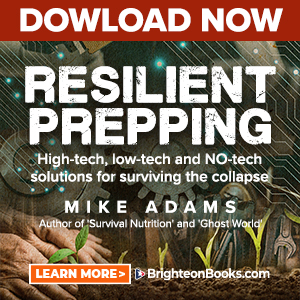
Is Gluten From Grains Making You Sick?
Monday, October 15, 2007 by: Leslee Dru Browning
Tags: gluten, celiac disease, health news
- Newly released JFK files reveal Pentagon's role in creating Lyme disease and covid in the same lab
- Discovery of vast underground city beneath Giza pyramids challenges human history
- Black cumin seed oil emerges as a powerful ally against breast cancer and chronic inflammation
- Sugar-free deception: Artificial sweeteners hijack hunger signals, fuel obesity epidemic, study warns
- Catastrophic 7.7 earthquake devastates Myanmar and Thailand; death toll could reach 100,000
- Kiss Your Genetic Privacy Good-Bye! 23andMe Gets Green Light to Sell Your Intimate Genetic Details to Anyone They Want
- AI breakthrough slashes celiac disease diagnosis time from months to minutes
- Europe braces for WAR as EU urges citizens to STOCKPILE FOOD, in latest provocations with Russia
- Aluminum pollution: A silent threat to human health
- Thomas Massie’s Dual Loyalty Disclosure Act aims to restore American sovereignty by cracking down on foreign influence in Congress
- Putin vows to 'finish off' Ukraine, accuses West of prolonging the war
- Dr. Suzanne Humphries makes bombshell appearance on Joe Rogan podcast, exposing vaccine industry deception back to POLIOMYELITIS
- The cancer fear industry: How big pharma profits from panic-and what natural alternatives offer
- The mighty Eggplant: An underrated superfood with ancient roots
- 200 Tesla showrooms bracing for Saturday protests as movement against Musk escalates
- Is the vaccine-autism debate reopening? Washington Post sparks controversy with preemptive hit piece on David Geier
- The great crypto power struggle: How technocrats and governments are reshaping global finance
- A handful of pecans a day could keep heart disease at bay, study finds
- Newly released JFK files reveal Pentagon's role in creating Lyme disease and covid in the same lab
- Analysis: The coming economic collapse, a mass uprising and Trump's three secret weapons to halt the growing revolt
- Trump nominates VACCINE ZEALOT Susan Monarez to lead the CDC, sidelining RFK Jr.'s reform efforts
- Trump's greatest betrayal so far: Accelerating Middle East wars, silencing dissent, and serving Zionist masters
- Dr. Mike Yeadon releases 15-minute testimony - WATCH - about genocidal intent of COVID “vaccines”
- Festive flavors: The sweet history, nutritional profile and health benefits of pecan pie
- Elon Musk: Aliens could be here on Earth RIGHT NOW
- Big Pharma's $8 Billion bribery scheme exposed: how doctors are pushed to prescribe junk science, not heal
- 5 Simple steps to boost your brainpower: How to strengthen executive function in a distracted world
- Trump reverses course on Gaza plan, says “nobody is expelling Palestinians”
- A lack of integrity in Academia: Harvard professor found GUILTY of fraudulent research to promote CRT theory
- Reclaim your health: How midlife exercise reverses years of inactivity
- Survival 101: Effective EMF blocking techniques
- Florida takes a stand: DeSantis proposes permanent ban on mRNA vaccine mandates
- Sugarcane extract superior to cholesterol-lowering drugs?
- California's social media censorship law struck down: A victory for free speech or a threat to online safety?
- OpenAI whistleblower who dissented against how the company trained ChatGPT found dead
- EPA advisor admits the agency is funneling billions to climate groups ahead of Trump’s return to White House
- EPA advisor admits the agency is funneling billions to climate groups ahead of Trump’s return to White House
- Newly released JFK files reveal Pentagon's role in creating Lyme disease and covid in the same lab
- California's social media censorship law struck down: A victory for free speech or a threat to online safety?
- Dr. Mike Yeadon releases 15-minute testimony - WATCH - about genocidal intent of COVID “vaccines”
- The Health Ranger releases “Vaccine Zombie” song and music video, using AI-animated zombies for the music video
- The pandemic as a tool for INDOCTRINATION: Understanding “The Indoctrinated Brain” by Dr. Michael Nehls
- Florida takes a stand: DeSantis proposes permanent ban on mRNA vaccine mandates
- “Why we influenced the 2020 elections”: Facebook files reveal the coordinated effort to bury the Hunter Biden laptop story
- Mike Adams releases country western hit single: Goin’ Back in Time is Comin’ Home
- Mike Adams releases music poetry sensation: A Child of God
- Unpacking the Lies That We’ve Been Fed – new song and music video released by Mike Adams, the Health Ranger
- Michigan sheriff announces criminal investigation into 2020 election crimes, Dominion Voting Systems
- Migrants are taking advantage of recent hurricanes to scam residents and loot their homes
- House Intelligence Committee calls for the ARREST and PROSECUTION of Dr. Anthony Fauci
- RFK Jr. clears key hurdle: Sen. Susan Collins backs controversial HHS nominee, signaling a new era for health policy
- Rep. Nancy Mace introduces bill to ban biological males from female facilities on federal property
- Peter Rost exposes Big Pharma corruption in his book “The Whistleblower: Confessions of a Healthcare Hitman”
- Mike Adams releases new song and music video: Nothing More Disgusting Than a Globalist
- Red Cross issues warning to stop blood plasma donations from vaccinated people
- Scientists confirm: GENIUS brain function can be spontaneously unleashed in humans without any apparent cause
- EPA advisor admits the agency is funneling billions to climate groups ahead of Trump’s return to White House
- HYSSOP: What research reveals about the health benefits of this ancient holy herb
- Two containers with completed ballots fall out of truck in Florida
- Fully vaccinated about to see “tsunami” of illness and death, warns virologist
- Global leaders unite to clamp down on “misinformation” with UN-backed Cascais Declaration
- BREAKING: 2025 NDAA authorizes mandatory military draft of WOMEN across America… as Pentagon pursues global NUCLEAR war with both Russia and China at the same time
- Michael Yon warns of a ZIONIST TAKEOVER in Trump’s second administration
- BOMBSHELL: DNA testing kits are a SCAM to develop ethnic-specific bioweapons
- Ozempic and Wegovy weight loss drugs are injectable LIZARD VENOM PEPTIDES that may unleash a devastating wave of organ failure… side effects align with symptoms of SNAKE BITES
- Israeli soldiers accused of even more torture and abuse in the West Bank
- These 13 countries just signed an agreement to engineer a global FAMINE by destroying food supply
- NASA admits that climate change occurs because of changes in Earth’s solar orbit, and NOT because of SUVs and fossil fuels
- RFK Jr. clears key hurdle: Sen. Susan Collins backs controversial HHS nominee, signaling a new era for health policy
- Sermon 30: How Jesus reveals Caesar’s FAKE CURRENCY and FALSE AUTHORITY
- Coriander seeds: Ancient medicine backed by modern science
- Arizona officials claim Maricopa County needs 10-13 days to tabulate results of the election
Celiac disease is an inherited disease of the digestive system that damages the villi in the small intestine causing chronic inflammation rendering it unable to digest foods. The villi enables food digestion. The damage to the villi is caused by the protein gluten found in the following grains: wheat, rye, barely. Some gluten intolerant people are also sensitive to oats and millet. Many with gluten sensitivity are also allergic to milk.
When people with celiac disease eat grains that contain gluten their immune system responds by damaging the small intestine which, over time, causes malnutrition due to malabsorption of nutrients. Malabsorption can cause someone to appear anorexic, but also, obese.
I found that many of my patients who were obese and complained of hunger were actually hungry. Once they embarked on a gluten-free diet to heal the small intestine their hunger cravings subsided and they lost their excess weight. Being too thin or too heavy is just one of many reasons to be tested for gluten-intolerance.
Symptoms of Gluten Intolerance:
Gluten Intolerance can cause an array of symptoms. It affects each person differently. Common complaints are behavioral changes; bone or joint pain; fatigue; pale, foul-smelling, or fatty stool; inability to gain weight; muscle cramps and muscle weakness; stomach problems; tingling and numbness in legs from nerve damage.
Reviews of celiac disease in the world's leading independent general medical journal Lancet lists the following known problems associated to gluten when celiac disease is not diagnosed:
Lancet 1997:349:1755
Lancet 2003:362:383
· Alopecia (abnormal hair loss)
· Anemia
· Mouth sores
· Arthritis
· Autoimmune diseases, glandular disorders or attacks on any organs are 10X more common in people with celiac
· Cancers (especially of the small bowel, lymphomas, esophageal)
· Dermatitis herpetiformis (a itchy skin rash)
· Elevated liver enzymes tests
· Gastroesophageal reflux (GERD)
· Gastrointestinal symptoms (abdominal discomfort, diarrhea, constipation)
· Infertility or miscarriage
· Irritable bowel syndrome
· Lactose intolerance
· Liver disease of unknown origin
· Malabsorption of nutrients & nutritional deficiency such as iron, folic acid, calcium, magnesium and fat soluble vitamins
· Neurological symptoms such as peripheral neuropathy, ataxia, epilepsy, cognitive dysfunction.
· Osteoporosis or osteopenia, check vitamin D level for malabsorption
· Psoriasis
Disease Linked to Celiac Disease:
People with celiac disease tend to have other autoimmune diseases. These diseases include epilepsy, thyroid disease, systemic lupus erythematosis, type 1 diabetes, vascular disease, rheumatoid arthritis and Sjogren’s syndrome. A diagnosis of multiple sclerosis has sometimes been given when in fact the person had celiac disease. Gluten may be the underlying causes of these autoimmune disorders.
How is Celiac Disease Diagnosed?
Years ago the only way to diagnose celiac disease was with a small bowel biopsy but today it can be diagnosed with simple blood tests that measure antibodies to gluten. Antibodies are proteins that react against the body. Those with celiac disease have high levels of antibodies to gluten in their blood. For the test to be accurate you must continue to eat grains containing gluten until you are tested. If not, the test results may be negative even if have celiac disease.
What is the Treatment?
The treatment does not involve medication. Instead, you simply must follow a gluten-free diet.
For most people, following a gluten-free diet, will stop symptoms and heal intestinal damage. It will also prevent further damage. Noticeable improvements usually begin within a week of starting the diet but the small intestine may take anywhere from 3 to 6 months in mild cases and up to 2 years in severe cases to completely heal so that villi that can absorb nutrients from food into the bloodstream.
The Gluten-free Diet
A gluten-free diet means not eating foods that contain wheat (including spelt, triticale, teff, and kamut), rye, barley and oats. The foods and products made from these grains are also not allowed therefore food label reading is a must. Hidden sources of gluten include food additives such as modified food starch, preservatives, and stabilizers along with medicines, anti-acids, vitamins, supplements and beverages.
People with celiac disease can eat rice, soy, amaranth, quinoa, potato, or bean flour instead of wheat flour. Grocery and health food stores now offer gluten-free bread, pasta, and other products. Gluten-free products are available on-line from many sources.
In order to stay healthy people with celiac disease must avoid gluten for the rest of their lives. Eating any gluten, no matter how minute an amount, can damage the small intestine.
Web References:
Excellent site for information on celiac disease. What to eat and where to purchase gluten- free foods:
Celiac Disease and Gluten-free Diet Information at www.Celiac.com
Foods that are safe for celiacs to eat and those that are not are listed at http://www.celiac.com/st_main.html?p_catid=12
Information on the FDA’s new position on gluten-labeling can be found at Food Navigator: http://www.foodnavigator-usa.com/news/ng.asp?n=80101&m=1FNU926&c=rmgrxyuscipjdni
Book Reference:
Living Gluten-Free for DUMMIES by Danna Korn
About the author
Leslee Dru Browning is a 6th generation Medical Herbalist & Nutritionist from the ancestral line of Patty Bartlett Sessions; Pioneer Mid-Wife & Herbalist. Leslee practiced Medical Herbalism and Nutritional Healing for over 25 years and specialized in Cancer Wellness along with Chronic Illness. She now devotes her career to teaching people, through her writing, about Natural Healing from An Herbal Perspective.Gluten at FETCH.news
Get independent news alerts on natural cures, food lab tests, cannabis medicine, science, robotics, drones, privacy and more.
Take Action: Support Natural News by linking to this article from your website
Permalink to this article:
Embed article link: (copy HTML code below):
Reprinting this article:
Non-commercial use OK, cite NaturalNews.com with clickable link.
Follow Natural News on Facebook, Twitter, Google Plus, and Pinterest
Science News & Studies
Medicine News and Information
Food News & Studies
Health News & Studies
Herbs News & Information
Pollution News & Studies
Cancer News & Studies
Climate News & Studies
Survival News & Information
Gear News & Information
News covering technology, stocks, hackers, and more



"Big Tech and mainstream media are constantly trying to silence the independent voices that dare to bring you the truth about toxic food ingredients, dangerous medications and the failed, fraudulent science of the profit-driven medical establishment.
Email is one of the best ways to make sure you stay informed, without the censorship of the tech giants (Google, Apple, Facebook, Twitter, YouTube, etc.). Stay informed and you'll even likely learn information that may help save your own life."
–The Health Ranger, Mike Adams












































